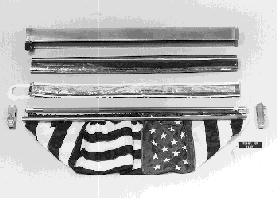fluttering flags







|
|
The flag was held oustretched by the crossbar through the top hem. The inner bottom corner was fastened to the pole. The outer bottom corner is free to move. The astute reader will have recognized this as a type of pendulum.
The astronauts said it was hard to drive the pole into the lunar surface. [Ibid.] Apollo 11 had no means of hammering it in. In later missions they reinforced the top of the pole so that a geology hammer could be used to drive it. During the process the flag pole was twisted in the fashion of a drill bit to bore it into the denser layers. Twisting the pole would cause the outer tip of the crossbar to describe an arc with a radius of about five feet (1.5 meters). The free corner of the flag, suspended from the tip, could whip back and forth.
In an atmosphere this motion would be impeded ("damped" in engineering terms) by air resistance. But on the moon there is no resistance from air to the pendulum motion of the flimsy fabric.
This process can be duplicated on earth. Slip the buckle of a belt over one end of a yardstick (or meter stick). Hold the other end of the stick and let the rest of the belt hang underneath it. Now move the stick left and right as if the hand holding it were a pole being twisted. Vary the speed. You will notice some complex pendulum motions at the bottom tip of the belt that look uncannily like the movements of the flag in the Apollo video. Why do we use a heavy object like a belt? Because we need something that won't be greatly affected by the air resistance on earth. In a vacuum the nylon fabric will have some of the same properties as the belt.
 In one video you can see
the flag move even though no astronaut is touching it. That could
only be caused by wind.
In one video you can see
the flag move even though no astronaut is touching it. That could
only be caused by wind.
In these instances the astronaut has just let go of the flagpole. The flagpole and its horizontal rod are bouncing, resonating in response to the residual motion from the astronaut's manipulation. If the wind is causing this motion then why are the flagpole and horizontal rod moving (bouncing), but the flag itself doesn't move at all? And why, in any of these cases, is there no secondary indication of wind such as blowing insulation on the lunar module or dust raised by the wind.
The flag is off-balance when the pole is perfectly vertical. It is balanced when tilted back slightly. Frequently the crossbar will rotate slightly just after being released by the astronaut, much as the door of an off-balance refrigerator will find its own equilibrium point.
 Why didn't the
astronauts smooth out the wrinkles in the flag?
Why didn't the
astronauts smooth out the wrinkles in the flag?
They thought it actually looked more familiar to have the flag slightly rumpled. The Apollo 11 astronauts could not get the telescoping crossbar to extend fully. On later missions the astronauts intentionally didn't pull it all the way out.


